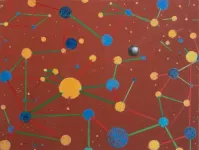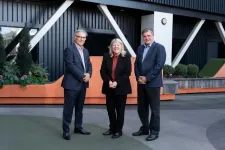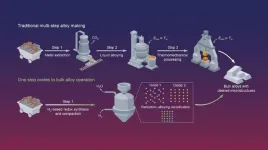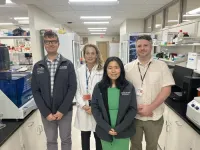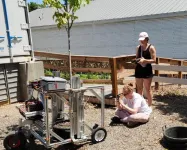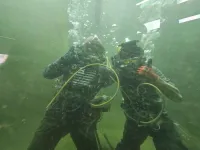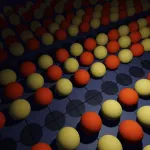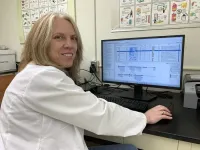(Press-News.org) The beliefs we hold develop from a complex dance between our internal and external lives. Our personal-level cognition and our relationships with others work in concert to shape our views of the world and influence how likely we are to update those views when we encounter new information. In the past, these two levels of belief have been studied largely in isolation: psychologists have modeled the individual-level cognitive processes while researchers in fields from computational social science to statistical physics have offered insights into how beliefs spread and change within a society.
“This disconnect when different disciplines are doing parallel work limits progress,” says Jonas Dalege, a former SFI Complexity Postdoctoral Fellow and current Marie Curie Fellow at the University of Amsterdam.
In a study published on September 19 in Psychological Review, Dalege and co-authors present the Networks of Beliefs theory, which integrates the interplay of individual- and social-level belief dynamics, and also incorporates social beliefs: how individuals perceive the beliefs of those around them.
“A crucial point about our model is that it’s about perceptions,” says Dalege, “You never actually know what a person thinks. If you identify very strongly as a Democrat, for instance, you might assume that your friends do as well. It can take a lot to shift those perceptions.”
The Networks of Beliefs theory “is the first to explicitly differentiate between personal, social, and external dissonances,” write the authors. “To fully understand when and why individuals change their beliefs, we need to understand how these dissonances together lead to different social phenomena.”
The Networks of Beliefs theory is built around three main premises.
The first is that beliefs can be represented as two interacting classes of networks: internal and external. The internal network is made up of various related beliefs — a person’s beliefs about vaccines, for instance, may be related to their beliefs about science, economics, and religion — as well as social beliefs. The external network describes how someone’s social beliefs relate to another’s actual beliefs and vice versa.
The second premise is that people want to reduce the dissonance in their beliefs, personally, socially, and externally. Someone might feel personal dissonance when they hold two conflicting beliefs — perhaps that vaccines are effective but also unsafe. Social dissonance arises when someone’s beliefs conflict with what they think people around them believe. External dissonance occurs when someone’s social beliefs — their perceptions of others — are out of sync with others’ actual beliefs.
The third premise is that the amount of dissonance a person feels depends on how much attention they pay to inconsistencies in their beliefs. This can vary widely based on personal and cultural preferences and depending on the issue at hand.
The authors then used an analogy with statistical physics to create a quantitative model of their new theory. “We map psychological concepts onto statistical physics concepts,” says SFI External Professor Henrik Olsson, a co-author on the paper and researcher at Complexity Science Hub in Austria. “We represent potential dissonance as energy and attention as temperature. This enables us to capitalize on well-known formalisms in statistical physics to model the complex dynamics of belief networks.”
The Networks of Belief theory allows researchers to model the interplay of individuals and the people around them, of perceived and actual beliefs, and of various levels of attention. And, it describes how beliefs change when we pay attention to different parts of our belief system.
“Sometimes we pay more attention to our personal dissonance and want to make sure that our beliefs are in tune with our own values,” says SFI Professor Mirta Galesic, who is also a co-author on the paper and a researcher at Complexity Science Hub. “Sometimes, maybe if we’re in a socially sensitive situation, we pay more attention to the dissonance between ours and others’ beliefs. In such situations, we might change our beliefs to conform to the perceived social pressure.”
The model, which the authors validated in two large surveys, could be applied to a variety of real-world problems. It could, for instance, offer new tools for tackling the increase in polarization around the world. “To understand and be able to do something about polarization, we have to look beyond just the individual or social answer,” says Dalege. “Partial answers can lead to dangerous policies. You might get the opposite effects of what you’re looking for.”
END
Study: Networks of Beliefs theory integrates internal & external dynamics
2024-09-19
ELSE PRESS RELEASES FROM THIS DATE:
Vegans’ intake of protein and essential amino acids is adequate but ultra-processed products are also needed
2024-09-19
In an article published in JAMA Network Open, researchers at the University of São Paulo’s Medical School (FM-USP) report on a study involving 774 men and women who followed a vegan diet in Brazil.
Their findings show that on average the participants consumed the recommended amount of proteins and essential amino acids, and that their diet consisted largely of unprocessed and minimally processed foods. However, participants who consumed proportionally lower levels of industrialized products such as protein supplements and textured soy protein were more likely to exhibit inadequate ...
Major $21 million Australian philanthropic investment to bring future science into disease diagnosis
2024-09-19
An outstanding $21 million philanthropic investment will establish a pioneering research centre to advance precision diagnosis for diseases that affect millions of Australians.
The Colonial Foundation Diagnostics Centre will use cutting-edge ‘spatial biology’ technologies to deliver enhanced diagnosis and, in turn, personalised care for patients with inflammatory diseases, like rheumatoid arthritis and inflammatory bowel disease.
The centre, co-led by WEHI and the Royal Melbourne Hospital, and funded by the Colonial Foundation, builds on an existing partnership that has pioneered potential new tests for detecting early-stage dementia.
At a glance
A $21 million ...
Innovating alloy production: A single step from ores to sustainable metals
2024-09-19
Metal production is responsible for 10% of global CO2 emissions, with iron production emitting two tons of CO2 for every ton of metal produced, and nickel production emitting 14 tons of CO2 per ton and even more, depending on the ore used. These metals form the foundation of alloys that have a low thermal expansion, called Invar. They are critical for the aerospace, cryogenic transport, energy and precision instrument sectors. Recognizing the environmental toll, scientists at the Max Planck Institute for Sustainable Materials (MPI-SusMat) have now developed a new method to produce Invar alloys without emitting ...
New combination treatment brings hope to patients with advanced bladder cancer
2024-09-19
Findings from the international FORT-2 clinical trial showed that a combination treatment including immunotherapy is safe and tolerable in patients with locally advanced or metastatic bladder cancer. The results, which were recently published in JAMA Oncology, show potential to broaden the number of patients with bladder cancer who could benefit from immunotherapy, an approach that harnesses a patient's own immune system to fight cancer.
“The major problem with immunotherapy was it works great for some patients with ...
Grants for $3.5M from TARCC fund new Alzheimer’s disease research at UTHealth Houston
2024-09-19
Studies by researchers at UTHealth Houston seeking to understand the underlying pathology of Alzheimer’s disease in order to discover new pathways to treatment have earned multiple awards totaling $3.5 million from the Texas Alzheimer’s Research and Care Consortium (TARCC).
A state-funded organization composed of 11 medical schools across the state, the goal of the TARCC is to fund Alzheimer’s-related projects within the member institutions and promote collaborative efforts. Rodrigo Morales, PhD, professor of neurology with McGovern Medical ...
UTIA researchers win grant for automation technology for nursery industry
2024-09-19
University of Tennessee Extension and UT AgResearch scientists have been awarded part of a nearly $10 million grant from the U.S. Department of Agriculture to study ways to use automation and robotics to address the labor shortage in the nursery crops industry.
Growing plants in a nursery is highly dependent on manual labor, making this industry particularly prone to worker shortages. An increasingly scarce workforce is limiting production, economic development and prosperity in the rural communicates where nurseries ...
Can captive tigers be part of the effort to save wild populations?
2024-09-19
Captive tigers in the United States outnumber those living in the wild. The World Wildlife Federation estimates around 5,000 of the big cats reside in the U.S., mostly owned by private citizens.
The health of this population is a genetic mystery for conservation groups and researchers interested in how the captive tigers could help stabilize or restore wild tiger populations. Are the privately owned animals just like tigers in the wild, or do they reflect characteristics popular in the illegal trade? Are they a hodgepodge of wild tiger ancestry, ...
The Ocean Corporation collaborates with UTHealth Houston on Space Medicine Fellowship program
2024-09-19
UTHealth Houston and The Ocean Corporation are collaborating on UTHealth Houston’s Space Medicine Training Fellowship program, which now includes a two-week intensive training focused on hyperbaric technologies and analog environments akin to those astronauts experience during extravehicular activities (EVAs), or space walks.
The training will enhance the hands-on learning experience of fellows in the Space Medicine Fellowship program, giving them a deeper understanding of physiological and medical challenges encountered in extreme environments.
“Integrating ...
Mysteries of the bizarre ‘pseudogap’ in quantum physics finally untangled
2024-09-19
By cleverly applying a computational technique, scientists have made a breakthrough in understanding the ‘pseudogap,’ a long-standing puzzle in quantum physics with close ties to superconductivity. The discovery, presented in the September 20 issue of Science, will help scientists in their quest for room-temperature superconductivity, a holy grail of condensed matter physics that would enable lossless power transmission, faster MRI machines and superfast levitating trains.
Certain materials involving copper and oxygen display superconductivity (where electricity flows without resistance) at relatively high — but still frigid — temperatures below ...
Study: Proteins in tooth enamel offer window into human wellness
2024-09-19
A new way of looking at tooth enamel could give scientists a path to deeper understanding of the health of human populations, from the ancient to the modern.
The method, published this week in the Journal of Archaeological Science, examines two immune proteins found embedded in human tooth enamel: immunoglobulin G, an antibody that fights infection, and C-reactive protein, which is present during inflammation in the body.
“These proteins are present in tooth enamel, and they are something we can use to study the ...
